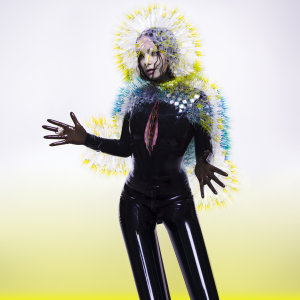When Vulnicura was released in early 2015, it marked a significant shift in Björk’s musical path. Known for pushing boundaries with concept-driven projects like Biophilia, which blended music with science and technology, Björk chose a very different route this time. Vulnicura stripped away the experimental layers to focus on something deeply human—grief, heartbreak, and healing. This return to emotional storytelling connected more closely with earlier records like Vespertine, yet felt even more raw and exposed.
What makes Vulnicura stand out is how it lays bare the pain of a breakup with an almost journal-like honesty. The album’s structure is tied to the timeline of Björk’s personal life, specifically her separation from longtime partner Matthew Barney. Each track reflects a point before or after the split, offering a window into the emotional stages she experienced. It’s rare for an artist known for abstraction to offer something this direct.
Sonic Exploration

Vulnicura is not an album that seeks comfort in simplicity. Its soundscape is as emotionally dense as its subject matter, shaped with meticulous care. The production is rich and layered, balancing clarity with a sense of emotional weight. The electronic textures—crafted in collaboration with Venezuelan producer Arca and British sound sculptor The Haxan Cloak—don’t just accompany the vocals, they echo them. The production is crisp where it needs to be, especially in its delicate string passages, but often veers into uneasy, jagged territory when emotion demands it. It doesn’t aim for smoothness. Instead, it reflects the internal tension of heartbreak.
The album’s arrangements are striking, not only for their complexity but also for their restraint. Strings play a central role, often swelling with melancholy or receding into quiet sorrow. They are not merely decorative. Rather, they serve as the emotional core. Björk’s voice, always expressive, is placed front and center. Her vocals are often exposed, unpolished in parts, and intentionally so. The vulnerability is part of the message. At times, the arrangements strip everything back to leave space for her voice to ache, while at other moments, synthetic beats crash against orchestral sweeps, creating a sense of chaos or collapse.
Genre-wise, Vulnicura inhabits a difficult-to-define space. It loosely falls under avant-pop, with strong elements of baroque pop, ambient, and experimental electronica. But what’s most compelling is how it blends classical instrumentation with modern electronic forms. Unlike earlier albums like Homogenic, where electronics often dominated, Vulnicura gives equal weight to both traditions. There’s no genre showboating here. Everything serves the narrative. The electronics aren’t flashy—they pulse like nerves under skin. The strings don’t romanticize—they mourn.
Lyrical Analysis

The lyrics of Vulnicura dive directly into the raw center of heartbreak. The album tells a clear emotional story—one of a deep personal rupture and the long road to healing. Björk maps this experience through a series of songs that are chronological in structure, giving the album a confessional, almost diaristic feel. Central themes include grief, betrayal, the loss of identity within a relationship, and the struggle to rebuild after emotional collapse.
These themes are not abstracted or hidden behind metaphor. On the contrary, many of the lyrics are remarkably direct. In “Black Lake,” she sings, “My soul torn apart / My spirit is broken,” with no need for symbolic language. It’s this honesty that gives the album its emotional weight. At the same time, Björk still weaves poetic flourishes into her writing. Tracks like “Family” and “Stonemilker” feature imagery that draws on natural forces and bodily sensations to describe emotional states, giving the listener both clarity and room to interpret.
Recurring motifs include the passage of time, the body as a vessel for pain, and the tension between dependency and independence. These ideas recur in different forms, whether in the repetition of words like “care” and “healing,” or in the use of phrases that mark time (“nine months before,” “eleven months after”), reinforcing the sense of lived experience.
Emotional Impact
The emotional impact of the lyrics is powerful and unflinching. Rather than offering a neat resolution or a clear sense of closure, Björk allows herself to inhabit the full range of emotional responses. Sadness is the dominant tone, but there is also anger, confusion, longing, and a fragile sense of hope. The effect is immersive. Listeners are not simply witnessing her pain—they’re drawn into it. By the end of the album, there is no neat catharsis, but there is a sense of resilience. Björk doesn’t ask for pity. She asks to be understood.
Cohesion and Flow

One of Vulnicura’s most remarkable qualities is its structure. From start to finish, the album follows a clear emotional arc, unfolding like a musical diary. Each track is tied to a specific point in time surrounding Björk’s breakup, and this framework gives the album a powerful sense of momentum. The first few songs—particularly “Stonemilker” and “Lionsong”—are soaked in longing and confusion. As the album moves into “Black Lake” and “Family,” the tone darkens, becoming heavier and more fractured. By the final tracks, there is a subtle but real shift toward acceptance and healing.
The track progression is deliberate and tightly woven. Each song feels like a natural extension of the last, even as they vary in length and intensity. The seamless transition between songs isn’t about musical uniformity—it’s about emotional continuity. The mood doesn’t fluctuate abruptly. Instead, the album invites the listener to walk through its stages in sequence, mirroring the uneven rhythm of recovery.
In terms of thematic consistency, Vulnicura holds together with impressive focus. Whether in the swelling string arrangements or the minimal, throbbing electronics, the sound remains aligned with the emotional tone. There are no unexpected diversions or jarring changes in style. Even the experimental production choices feel anchored in the album’s core themes of loss and survival. Björk resists the temptation to shift genres or offer relief through lighter interludes. This artistic discipline strengthens the album’s impact. It feels less like a collection of songs and more like one continuous emotional journey.
Standout Tracks and Moments
Among Vulnicura’s nine sprawling tracks, several stand out for their emotional intensity and compositional depth.
Stonemilker
The opener, “Stonemilker,” sets the tone with aching strings and a circular structure that echoes the desire for emotional symmetry. It’s one of the more accessible moments on the album, but its simplicity is deceptive. The way Björk pleads for “emotional respect” over gently shifting harmonies is both tender and devastating. It captures the wish to restore balance before anything has fully unraveled.
Black Lake
The album’s centerpiece, “Black Lake,” is arguably its most monumental track. Stretching over ten minutes, it unfolds slowly, almost reluctantly, mirroring the paralysis of heartbreak. Björk’s vocal delivery is haunting and restrained, gradually building tension without release. The song’s sparseness—its long silences, its near-absence of beats until the halfway point—makes each lyric hit harder. When she sings, “You have nothing to give, your heart is hollow,” it’s like watching someone break in real time. The subtle introduction of electronic textures halfway through acts like a pulse returning to a body, a chilling metaphor for emotional awakening after trauma.
Family
Another highlight is “Family,” which dives into darker, more experimental territory. Its brooding sonic landscape, filled with distorted electronics and droning strings, reflects a grief that is not just romantic but existential. The track includes one of the most memorable instrumental moments on the album: a slow, grinding string motif that sounds like emotional architecture collapsing. It’s raw and unrelenting.
Memorable Moments
Later in the album, “Notget” and “Quicksand” shift the emotional tone. “Notget” feels like a turning point—less about loss and more about survival. It blends urgency with defiance, signaling a move toward empowerment. “Quicksand,” the closing track, is the shortest and most sonically urgent. It ends the album on a restless note, refusing a clean resolution but hinting at motion, at life continuing even in uncertainty.
There are also subtler moments that deserve attention. The whispered backing vocals in “Lionsong,” the cello swells in “Mouth Mantra,” and the careful use of space and silence throughout—all reveal Björk’s mastery of detail. These flourishes don’t distract; they deepen the emotional experience.
Artistic Contribution and Innovation

Vulnicura occupies a unique space within the broader landscape of contemporary music. While it draws from genres like avant-pop, experimental electronica, and baroque pop, it refuses to fit neatly into any one category. In an industry often driven by trends and formulaic releases, Björk’s album stands out as a daring act of emotional and artistic honesty. It pushes boundaries by merging the intimacy of classical string arrangements with cutting-edge electronic production, creating a soundscape that feels both timeless and strikingly modern.
Innovation
The album’s innovation lies as much in its emotional rawness as in its sonic design. Björk’s decision to chronicle the breakup process in real time—mapping songs to specific months before and after the split—is rare in popular music. This narrative transparency invites listeners into a deeply personal space, making the album feel less like entertainment and more like a shared experience of vulnerability.
On a production level, the collaboration with Arca and The Haxan Cloak brought fresh textures to Björk’s music. The electronic elements aren’t just embellishments; they respond to and amplify the album’s emotional core. This fusion of organic strings with fragmented, often unsettling electronics creates a tension that mirrors the complexities of grief. Such a hybrid approach was still relatively rare in mainstream music at the time, showcasing Björk’s continued role as a pioneer.
Thematically, Vulnicura pushes against the typical romantic breakup album by refusing closure or glossing over pain. Instead, it embraces ambiguity and ongoing healing, which feels more honest and relatable. This willingness to expose vulnerability without offering easy answers adds to its artistic weight.
Closing Thoughts

Vulnicura stands as one of Björk’s most emotionally powerful and artistically daring works. Its greatest strength lies in its unflinching honesty—the way it exposes heartbreak not as a poetic abstraction but as a lived, raw experience. Musically, the album excels in blending classical strings with cutting-edge electronic production, creating a sound that is both timeless and avant-garde. The production is detailed and immersive, serving the emotional narrative with precision.
That said, Vulnicura is not an easy listen. Its intensity and focus on grief may challenge some listeners who prefer lighter or more uplifting music. At times, the album’s dense sonic layers and haunting vocal delivery demand patience and attention. However, this complexity is part of its brilliance; it rewards listeners willing to engage deeply.
In the context of Björk’s career, Vulnicura feels like a milestone—an album that pushes her artistry into new emotional and sonic territory without abandoning the adventurous spirit she is known for. It reaffirms her role as a trailblazer who continually redefines what music can express.
Official Rating: 10/10
For these reasons, I give Vulnicura a perfect 10 out of 10. It is an album that transforms personal pain into a universal language, offering an honest and innovative exploration of heartbreak. Its impact goes beyond music; it is a work of art that invites empathy, reflection, and healing. In both emotional depth and artistic ambition, Vulnicura stands tall as one of the great albums of its time.
